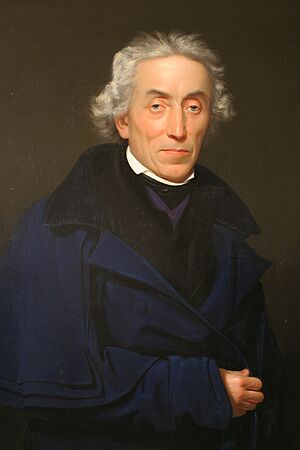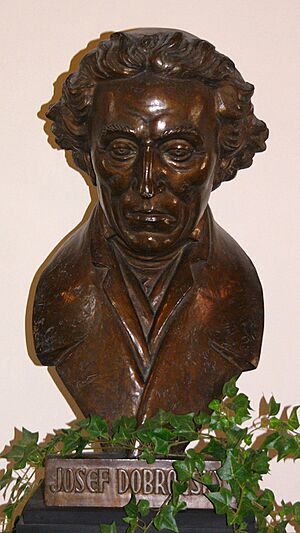Josef Dobrovský facts for kids
Quick facts for kids
Josef Dobrovský
|
|
|---|---|

Josef Dobrovský by František Tkadlík
|
|
| Born | 17 August 1753 Balassagyarmat, Kingdom of Hungary, Habsburg monarchy
|
| Died | 6 January 1829 (aged 75) |
|
Main interests
|
philology, history |
|
Influences
|
|

Josef Dobrovský (born August 17, 1753 – died January 6, 1829) was a very important Czech scholar. He was a philologist, meaning he studied languages and old texts. He was also a historian, someone who studies the past.
Dobrovský was a key figure in the Czech National Revival. This was a time when Czech people worked hard to bring back their language, culture, and national pride. He helped shape the modern Czech language.
Contents
Early Life and Education
Josef Dobrovský was born in Balassagyarmat, a town in what was then the Kingdom of Hungary. His father was a soldier. Josef first learned German at school. Later, he learned Czech and became very good at it.
He studied philosophy at the Charles University in Prague. In 1772, he joined the Jesuits in Brno. He planned to become a missionary in India. However, the Jesuit order was closed down in the Czech lands in 1773. So, Dobrovský went back to Prague to study theology.
A Scholar's Journey
After his studies, Dobrovský worked as a tutor for Count Nostitz. He then became a leader at a seminary in Hradisko. In 1790, he lost this job when the seminaries were closed. He returned to live with the Count. During this time, he wrote many important books. These books were about Slavic languages, history, and language studies.
In 1792, the Bohemian Academy of Sciences sent him on a special trip. He traveled to places like Stockholm, Saint Petersburg, and Moscow. His goal was to find old manuscripts that were lost during the Thirty Years' War. After his trip, he traveled with Count Nostitz to Switzerland and Italy.
Dobrovský was very active in academic life in Prague. In 1784, he helped start the Royal Czech Society of Sciences. Later, in 1818, he helped create the National Museum. This museum is now a major cultural site in the Czech Republic.
Later Years and Legacy
Around 1795, Dobrovský faced some health challenges. In 1801, he needed time to recover. By 1803, he was completely well again. He spent most of his later life in Prague. He also stayed at the homes of his friends, the Counts Nostitz and Czernin. He passed away in Brno in 1829. He had gone there to study in the local libraries.
Dobrovský is most famous for his work on Slavic languages. But he also studied plants, which was important for science at the time.
A famous Czech poet, Vladimír Holan, lived in a house on Kampa Island. This house was known as the "Dobrovský House." The poet often said that Dobrovský, who was sometimes called the Blue Abbé, would visit him.
Key Works and Contributions
Dobrovský wrote many important books and articles. These works helped people understand Slavic languages and Czech history better. Here are some of his most important writings:
- Fragmentum Pragense evangelii S. Marci, vulgo autographi (1778)
- A magazine about Bohemian and Moravian literature (1780–1787)
- Scriptores rerum Bohemicarum (2 volumes, 1783)
- Geschichte der böhm. Sprache und alten Literatur (History of the Bohemian Language and Old Literature) (1792)
- Die Bildsamkeit der slaw. Sprache (The Formability of the Slavic Language) (1799)
- A German-Bohemian Dictionary, created with other scholars (1802–1821)
- Entwurf eines Pflanzensystems nach Zahlen und Verhältnissen (Outline of a Plant System by Numbers and Ratios) (1802)
- Glagolitica (1807)
- Lehrgebäude der böhmischen Sprache (Textbook of the Bohemian Language) (1809)
- Institutiones linguae slavicae dialecti veteris (Institutions of the Old Slavic Dialect) (1822)
- Entwurf zu einem allgemeinen Etymologikon der slaw. Sprachen (Outline for a General Etymological Dictionary of Slavic Languages) (1813)
- Slowanka zur Kenntnis der slaw. Literatur (Slavica for the Knowledge of Slavic Literature) (1814)
- A special edition of Jordanes' De rebus Geticis for Georg Heinrich Pertz's Monumenta Germaniae Historica
You can learn more about his life in a book by František Palacký, called J. Dobrowskys Leben und gelehrtes Wirken (1833).
See also
- List of Jesuit scientists
- Josef Dobrovský Monument


